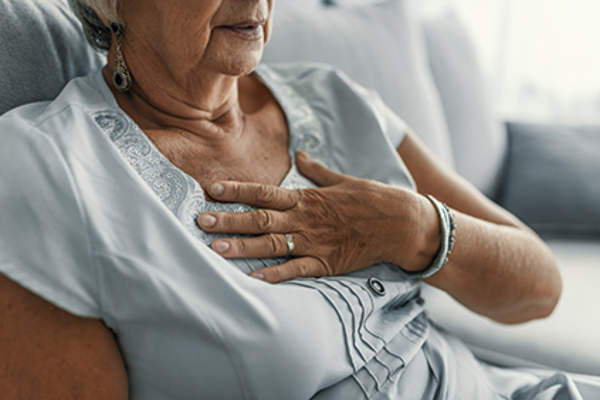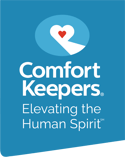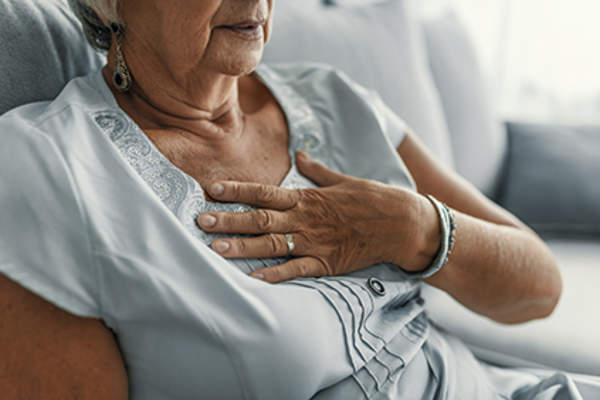A person with chronic obstructive pulmonary disease (COPD) experiences long-term, progressive damage to their lungs. This affects airflow to the lungs. Doctors sometimes call this condition emphysema or chronic bronchitis--which are forms of COPD.

A person with COPD can experience a period when their symptoms are much worse than usual. This is known as an acute exacerbation or “flare-up” in layman’s terms. They may need to seek medical help at a hospital.
The average person with COPD has between 0.85 and 1.3 exacerbations a year.
COPD exacerbations can be harmful because they can cause further damage to the lungs. If you’ve been diagnosed with COPD, preventing an exacerbation from occurring can help you live a healthier life and reduce the risk of death.
Things to Watch For
Self-awareness is important with COPD flare-ups. Only you can know how you feel on a typical day -- how your breathing feels and how much you cough. Pay close attention when things change.
One obvious sign of an oncoming flare-up is shortness of breath or “tightness” in your lungs. You feel like you can’t get enough air. You might notice it during light physical activity or even when you are at rest.
Be aware of these indicators
- Noisy breathing. Your breath makes strange noises. Wheezing suggests mucus or pus is blocking your airways. Gurgling or rattling could mean fluid in your lungs.
- Irregular breathing. You feel like you have to use your chest muscles to breathe instead of your diaphragm. Your breathing becomes uneven. Sometimes your chest moves a lot faster; sometimes it’s much slower.
- Worse coughing. It’s more severe or you cough more often than usual. It could be dry or bring up yellow, green, or bloody phlegm. It gets worse when you lie down -- so much that you may have to sit in a chair to sleep.
- Changes in skin or nail color. You see a bluish tint around your lips or notice that your nails seem blue or purple. Your skin looks yellow or gray.
- Trouble sleeping and eating. You can’t get to sleep, and you don’t feel like eating.
- You can't talk. You're unable to get any words out. You have to use hand gestures to let someone know something is wrong with you. This is a late and dangerous sign of worsening breathing.
- Early-morning headaches. You start the day with a throbbing head because of a buildup of carbon dioxide in your blood.
- Swollen ankles or legs or belly pain. These symptoms are linked to problems with your heart or lungs.
- Fever. A higher temperature could be a sign of infection and an oncoming flare-up.
You should call your doctor at once if you or a loved one with COPD are showing symptoms of a flare-up.
Avoiding Triggers and Flare-Ups
Air quality is important both inside your home and while outside. Pay attention to triggers outside like air pollution or if you have allergies. A smartphone application like Accuweather can help track these things or a radio station that keeps people informed about these topics. The inside of your home is also important. Keep dust to a minimum and clean air moving in your home. You may want to invest in a good filtration system if you have a forced-air HVAC system. Some fans also come with HEPA filters to reduce pollen and dander in the air. Reduce or eliminate smoke in your home. Some medical professionals recommend the elimination of carpets, rugs, drapes, and other things that trap dust in the home. If you can’t or won’t eliminate them, you may want to have them cleaned more often. Some companies offer special charged water, steam, or chemicals that won’t cause exacerbation--be sure to ask!
Ideas to Avoid Flare-ups
- Take care of yourself and try to avoid cold, flu and other infectious diseases.
- Take all your medications as directed.
- Eat right.
- Get enough sleep.
- Exercise.
- Stay away from people who are sick.
- Get your flu shot, and ask about getting a pneumonia shot.
- Wash your hands properly and often.
- Follow your COPD Action Plan.
COPD and Anxiety
People with COPD often struggle for breath. The brain reacts to this by sending signals of distress. These distress signals may trigger anxiety, which can lead to a panic attack in some people. Panic attacks and anxiety can also cause a person to have difficulty breathing or to change their normal breathing patterns. Due to this overlap of symptoms, a person with COPD often becomes trapped in a cycle in which the breathing difficulties of COPD trigger anxiety, which makes it even more difficult to breathe. People with COPD are often aware of the symptoms of a panic attack, as it is normal for the brain to send stress signals out during an episode of breathlessness.
Panic attacks can be dangerous for people with COPD because they can exacerbate breathing difficulties and make it even more challenging to get air from each breath, leading to worsening symptoms. There are many ways to identify a panic attack. A panic attack may:
- be sudden and intense
- come on without warning
- cause an irrational level of fear
According to the Mayo Clinic panic attacks typically include some of these signs or symptoms:
- Sense of impending doom or danger
- Fear of loss of control or death
- Rapid, pounding heart rate
- Sweating
- Trembling or shaking
- Shortness of breath or tightness in your throat
- Chills
- Hot flashes
- Nausea
- Abdominal cramping
- Chest pain
- Headache
- Dizziness, lightheadedness or faintness
- Numbness or tingling sensation
- The feeling of unreality or detachment
Coping and Strategies
Today more than ever there are a tremendous number of coping strategies you can discuss with your pulmonary health professional. They can range from meditation, breathing techniques, CBD oils, mental health therapy, natural therapies, and medications. Unchecked, these feelings of stress can lead to depression or the worsening of your COPD.
According to the American Lung Association, coping with your emotions is an important part of caring for yourself or your loved one who is living with COPD. Support groups, like the Better Breathers Clubs, are wonderful because not only do they decrease isolation, which can lead to depression, but they make you feel a part of a community that really understands what you’re going through. Support groups can create feelings of hopefulness and provide an opportunity for you to learn new coping skills. There is often a sharing of resources and ideas that you would not have access to in a typical social setting.
Altogether, this can make a great impact on one’s mental health. It can feel uncomfortable at first, but if you stick with it, you can reap all of the benefits groups have to offer.
As you start to cope with the disease, start getting back to normal by doing those things you love--even if you have to do them slower or modify them somewhat. If you like to walk, find a place that has a bench to rest on at the midway point. Find a friend that will help you get out there but keep you in check if you start to go overboard. When dealing with depression, mental health experts agree that starting slow, even by creating a list of things to do and crossing them off when done, can help you on your way to feeling more accomplished. Once you start making headway you should start feeling good again about being able to live with COPD and staying as active as possible.
What To Do if You Have a Flare Up
Ideally, you will have a flare-up action plan developed with your doctor in advance of something actually occurring. Follow the directions you have developed with your doctor immediately to help prevent the issue from becoming more serious. This can greatly reduce the chances of issues with your lungs becoming more serious. If you don’t have an action plan already in place, call your doctor if you notice the signs of a flare-up. If you are following your plan, or don’t have a plan, and things become more concerning, go to the hospital for treatment. Bring the information with you on what medications you are currently taking so they can consider this when they are determining how to best help you.
Check out our website for more information and resources on COPD!
Resources
The Lung Association--Breathe
WebMD
Environmental Protection Agency
Healthcentral.com





